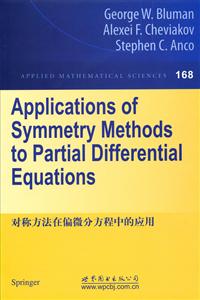对称方法在偏微分方程中的应用

|
对称方法在偏微分方程中的应用作者:布鲁曼 开 本:24开 书号ISBN:9787510086267 定价:79.0 出版时间:2015-01-01 出版社:世界图书出版公司 |
对称方法在偏微分方程中的应用 内容简介
This book is a sequel to Symmetries and Integration Methods (2002), by George W. Bluman and Stephen C. Anco. It includes a significant update of the material in the last three chapters of Symmet'ries an,d Dzjjerential Equa-tions (1989; reprinted with corrections, 1996), by George W. Bluman and Sukeyuki Kumei. The emphasis in the present book is on how to find sys-tematically symmetries (local and nonlocal) and conservation laws (local and nonlocal) of a given PDE system and how to use systematically symmetries and conservation laws for related applications. In particular, for a given PDE system, it is shown how systematically (1) to find higher-order and nonlocal symmetries of the system; (2) to construct by direct methods its conserva- tion laws through finding sets of conservation law multipliers and formulas to obtain the fluxes of a conservation law from a known set of multipliers; (3) to determine whether it has a linearization by an invertible mapping and con- struct such a linearization when one exists from knowledge of its symmetries andlor conservation law multipliers, in the case wheii the given PDE system is nonlinear; (4) to use conservation laws to construct equivalent nonlocally related systems; (5) to use such nonlocally related systems to obtain nonlo- cal symmetries, nonlocal conservation laws and non-invertible mappings to linear systems; and (6) to construct specific solutions from reductions arising from its symmetries as well as from extensions of symmetry methods to find such reductions. This book is aimed at applied mathematicians; scientists and engineers interested in finding solutions of partial differential equations and is written in the style of the above-mentioned 1989 book by Bluman and Kumei. There are numerous examples involving various well-known physical and engineering PDE systems.
对称方法在偏微分方程中的应用 目录
PrefaceIntroduction
1 Local Transformations and Conservation Laws
1.1 Introduction
1.2 Local Transformations
1.2.1 Point transformations
1.2.2 Contact transformations
1.2.3 Higher-order transformations
1.2.4 One-parameter higher-order transformations
1.2.5 Point symmetries
1.2.6 Contact and higher-order symmetries
1.2.7 Equivalence transformations and symmetry classification
1.2.8 Recursion operators for local symmetries
1.3 Conservation Laws
1.3.1 Local conservation laws
1.3.2 Equivalent conservation laws
1.3.3 Multipliers for conservation laws.Euler operators
1.3.4 The direct method for construction of conservation laws.Cauchy-Kovalevskaya form
1.3.5 Examples
1.3.6 Linearizing operators and adjoint equations
1.3.7 Determination of fluxes of conservation laws from multipliers
1.3.8 Self-adjoint PDE systems
1.4 Noether's Theorem
1.4.1 Euler-Lagrange equations
1.4.2 Noether's formulation of Noether's theorem
1.4.3 Boyer's formulation of Noether's theorem
1.4.4 Limitations of Noether's theorem
1.4.5 Examples
1.5 Some Connections Between Symmetries and Conservation Laws
1.5.1 Use of symmetries to find new conservation laws from known conservation laws
1.5.2 Relationships among symmetries,solutions of adjoint equations,and conservation laws
1.6 Discussion
2 Construction of Mappings Relating Differential Equations
2.1 Introduction
2.2 Notations; Mappings of Infinitesimal Generators
2.2.1 Theorems on invertible mappings
2.3 Mapping of a Given PDE to a Specific Target PDE
2.3.1 Construction of non-invertible mappings
2.3.2 Construction of an invertible mapping by a point transformation
2.4 Invertible Mappings of Nonlinear PDEs to Linear PDEs Through Symmetries
2.4.1 Invertible mappings of nonlinear PDE systems(with at least two dependent variables)to linear PDE systems
2.4.2 Invertible mappings of nonlinear PDE systems(with one dependent variable)to linear PDE systems
2.5 Invertible Mappings of Linear PDEs to Linear PDEs with Constant Coefficients
2.5.1 Examples of mapping variable coefficient linear PDEs to constant coefficient linear PDEs through invertible point transformations
2.5.2 Example of finding the most general mapping of a given constant coefficient linear PDE to some constant coefficient linear PDE
自然科学 数学 微积分
在线阅读
- 最新内容
- 相关内容
- 网友推荐
- 图文推荐
| [高考] 2022 西安电子科技大学《软件工程》大作业答案 (2022-04-25) |
| [家长教育] 孩子为什么会和父母感情疏离? (2019-07-14) |
| [教师分享] 给远方姐姐的一封信 (2018-11-07) |
| [教师分享] 伸缩门 (2018-11-07) |
| [教师分享] 回家乡 (2018-11-07) |
| [教师分享] 是风味也是人间 (2018-11-07) |
| [教师分享] 一句格言的启示 (2018-11-07) |
| [教师分享] 无规矩不成方圆 (2018-11-07) |
| [教师分享] 第十届全国教育名家论坛有感(二) (2018-11-07) |
| [教师分享] 贪玩的小狗 (2018-11-07) |






